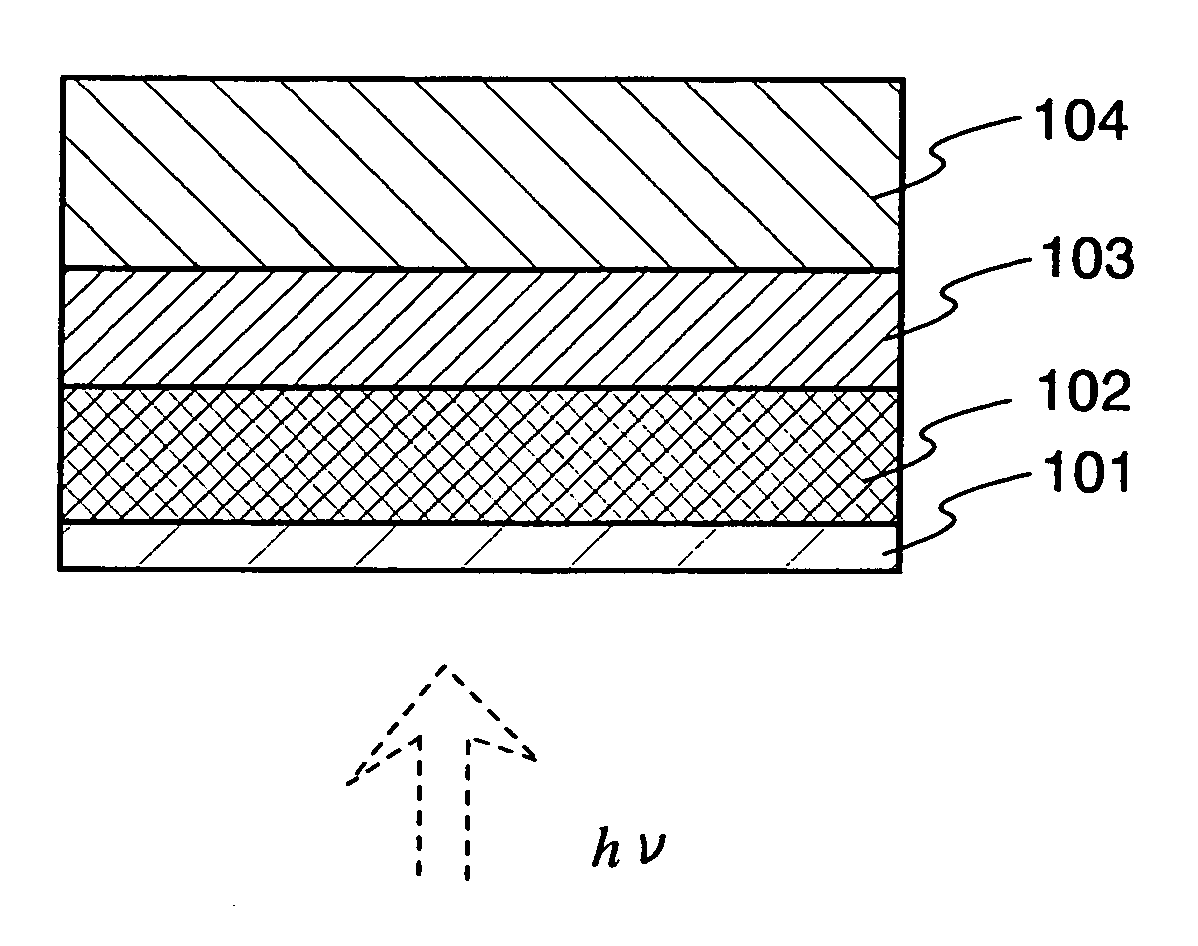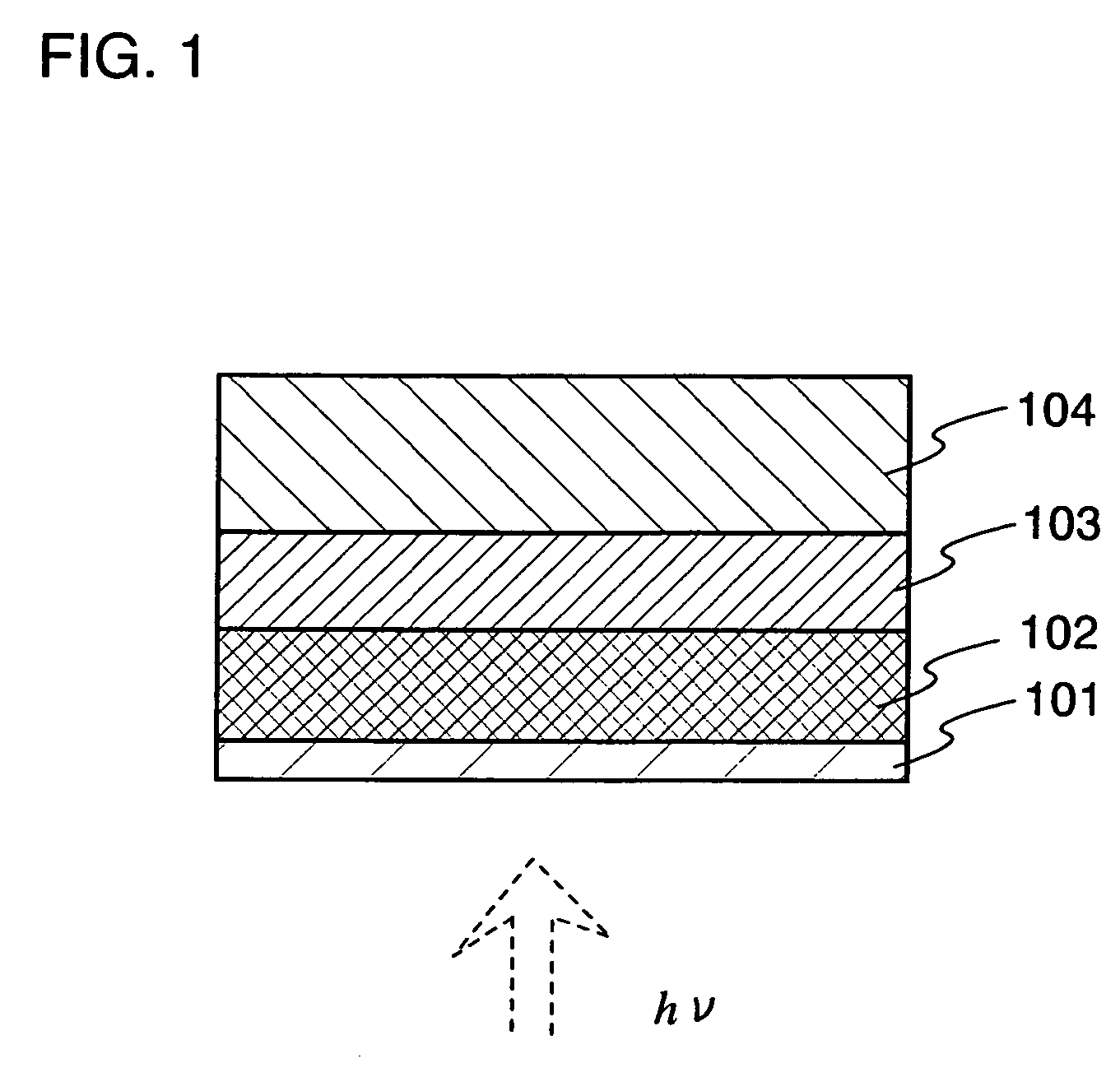Photoelectric conversion element, solar battery, and photo sensor
- Summary
- Abstract
- Description
- Claims
- Application Information
AI Technical Summary
Benefits of technology
Problems solved by technology
Method used
Image
Examples
embodiment mode 1
[0044]FIG. 1 shows an element structure of a photoelectric conversion element of the invention. Here, a charge generating layer is formed of a layer containing an organic compound and an inorganic compound each of which has a hole transporting property and a charge acceptor layer is formed of an organic compound having an electron transporting property.
[0045] The photoelectric conversion element has a stacked-layer structure in which a first electrode 101, a charge generating layer 102, a charge acceptor layer 103, and a second electrode 104 are sequentially stacked.
[0046] The first electrode 101 is formed of a material which is conductive and has high light transmissivity against a wavelength region of an incident excited light. The first electrode 101 is formed by a vacuum vapor deposition method, a sputtering method and the like, and a thickness thereof is not limited. It is preferable to use a metal and a metal oxide, in particular Al, indium tin oxide (ITO), SnO2, and In2O3 c...
embodiment mode 2
[0058]FIG. 2 shows an element structure of a photoelectric conversion element. Here, a charge generating layer is formed of a layer containing an organic compound and an inorganic compound each of which has an electron transporting property and a charge acceptor layer is formed of an organic compound having a hole transporting property.
[0059] A charge acceptor layer 202 is formed over the first electrode 101 and a charge generating layer 203 is formed over the charge acceptor layer 202.
[0060] The charge generating layer 203 is formed of an organic compound and an inorganic compound each of which has an electron transporting property. The organic compound having an electron transporting property may be formed of the substance having an electron transporting property specifically described in Embodiment Mode 1. The inorganic compound is preferably formed of a metal oxide or a metal nitride each of which shows an electron donating property to the first organic compound, and more pref...
embodiment mode 3
[0062]FIG. 3 shows an element structure of a photoelectric conversion element and a solar battery of the invention. Here, a first charge generating layer is formed of a layer containing an organic compound having a hole transporting property and a first inorganic compound. A second charge generating layer is formed of a layer containing an organic compound having an electron transporting property and a second inorganic compound.
[0063] A first charge generating layer 302 is formed over the first electrode 101 and a second charge generating layer 303 is formed over the first charge generating layer 302.
[0064] The first charge generating layer 302 may be formed of the substance of the charge generating layer 102 specifically described in Embodiment Mode 1. The second charge generating layer 303 may be formed of the substance of the charge generating layer 203 specifically described in Embodiment Mode 2.
PUM
 Login to View More
Login to View More Abstract
Description
Claims
Application Information
 Login to View More
Login to View More - R&D
- Intellectual Property
- Life Sciences
- Materials
- Tech Scout
- Unparalleled Data Quality
- Higher Quality Content
- 60% Fewer Hallucinations
Browse by: Latest US Patents, China's latest patents, Technical Efficacy Thesaurus, Application Domain, Technology Topic, Popular Technical Reports.
© 2025 PatSnap. All rights reserved.Legal|Privacy policy|Modern Slavery Act Transparency Statement|Sitemap|About US| Contact US: help@patsnap.com



